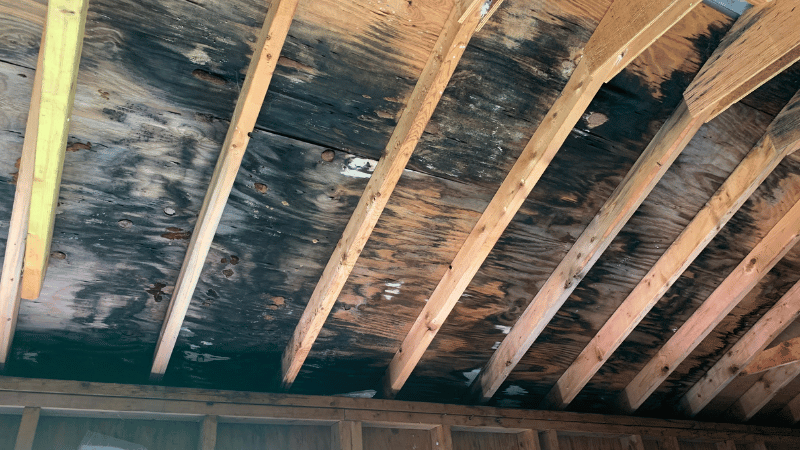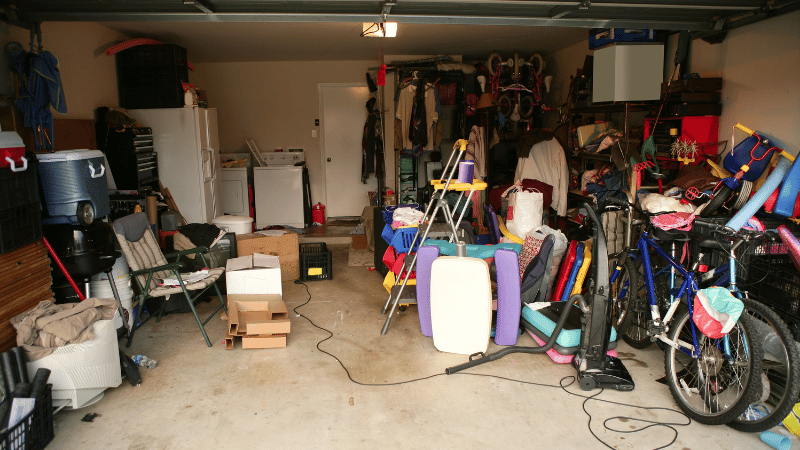The garage is the last place a homeowner looks for mold—but an infestation can spread rapidly when conditions remain consistently damp, dark, and inadequately ventilated. The garage is one of the perfect breeding grounds for mold. Act fast when mold is spotted here.
What are signs of mold in the garage?
Mold spores are not picky eaters. They feed on organic material, like drywall, which the typical garage has plenty of. Plus, mold spores are nourished by a constant supply of moisture, which can creep into the garage when the door opens, and wet weather conditions intrude.
A telltale sign of mold in the garage is a distinctive musty odor, which is often likened to the smell of wet, dirty socks. Or mold growth can be seen as dark splotches growing on surfaces in the garage. Mold is also notorious for growing unseen behind walls and ceilings.
Sensitive homeowners may react physically when exposed to mold. Allergic reactions that can appear when walking into a moldy garage include coughing, skin irritations, and itchy red eyes. Asthma symptoms worsen in individuals who are diagnosed with a respiratory condition.
Why does mold grow in the garage?
Unfinished garages are especially prone to mold contamination. The high humidity and condensation levels, ineffective ventilation, and lack of natural light create optimal conditions for the growth of mold colonies. Spores can be carried inside by wind when the garage door is opened several times a day.
Water damage from a leaky pipe, a leaky roof, or a lack of a functional drainage system in the garage create hospitable conditions for mold growth. Excessive rain, snow, and ice from vehicles drip onto the floor, leading to the moist environment in which mold spores thrive.

How do homeowners remove mold from the garage?
Step 1: Contain the Area
Under damp conditions, mold multiplies within 24 to 48 hours. Homeowners must act quickly when they spot mold anywhere in the garage. First contain the area with plastic sheeting to prevent airborne mold spores from contaminating other parts of the garage.
Step 2: Clean the Mold
Prior to cleaning, ensure the garage is properly ventilated. Wear gloves, goggles, and a face mask to prevent exposure to the spores. Clean the affected areas with distilled white vinegar or a commercial mold removal product. Household detergent mixed with water is an alternative cleaning solution.
A commercial product specifically designed to eliminate mold is, however, most effective. Spray the areas affected by mold growth. Never “dry scrub” mold colonies. Allow the cleaner to sit on the splotches of mold for a short period, then scrub with a soft bristled brush.
Step 3: Rinse the Cleaned Area
After scrubbing the cleaning product into the moldy areas, rinse with clean water. Inspect the newly cleaned spots. If the mold colonies stubbornly persist, repeat the cleaning process until the mold completely disappears. Dry the area thoroughly and monitor it for signs of re-emerging mold.
Small areas of mold can be cleaned up by the homeowner as a DIY task. However, the Environmental Protection Agency (EPA) recommends the services of a certified mold remediation company in instances of widespread mold colonies of over 10 square feet.
What prevents mold growth in the garage?
A well-ventilated garage does not attract mold spores. Along with ensuring adequate ventilation, homeowners should routinely inspect their garage for leaks; look for puddles on the floor and water stains on the ceilings. If water damage is visible, repair it immediately.
Seal the garage door to prevent moisture intrusions. Crumbling, torn, or otherwise damaged weatherstripping requires replacement. When signs of excessive moisture appear, such as mineral deposits or damp areas, address the issues promptly. Regularly check for burst or leaky pipes.
Reduce humidity levels and moisture buildup in the garage by running a dehumidifier. Consider opening a garage window to let in natural sunlight. The ultraviolet radiation in the sun’s rays kills mold spores. In most cases, only a few hours of direct sunlight are necessary to eliminate mold.
If a drain is built into the garage floor, ensure it is not clogged by debris or blocked by items. By maintaining proper drainage, water does not pool in the garage. The garage floor should ideally slope to divert water out of the garage and prevent moisture issues, like mold.
When renovating the garage, consider using mold-resistant materials. Mildew-resistant paint is recommended for coating concrete garage floors. Rather than storing wet items on the garage floor and exposing them to damp conditions, elevate them onto metal shelves or use plastic bins.
Keeping moisture out of the garage is the most effective way to prevent mold growth. But when a mold infestation invites itself in, homeowners can make several attempts to tackle the cleanup themselves or consult a qualified mold removal company, like ServiceMaster by Replacements.
Only one visit from our professional mold cleanup company is necessary to rid the garage of mold colonies. Rather than spend hours cleaning the mold, homeowners can turn to us. Our technicians are equipped with specialized tools, professional grade products, and skills to perform the job faster.
Our mold cleanup crews utilize advanced infrared technology to locate all traces of visible and concealed mold, including infestations hidden behind the walls. Once mold is detected, we isolate the affected space to prevent cross-contamination to other parts of the garage.
Cleanup begins with safe yet effective chemical cleaners. If structural damage has occurred due to the mold growth, our technicians perform restorations and repairs. After all the mold is removed, we conduct a final test to ensure no mold spores remain on the property.
Mold in the garage or any other part of your New Jersey home requires swift and professional attention from ServiceMaster by Replacements. We stand by 24 hours a day to respond to calls for mold removal.
To learn more about our mold removal services, make sure to call us today at (732) 842-6917.







